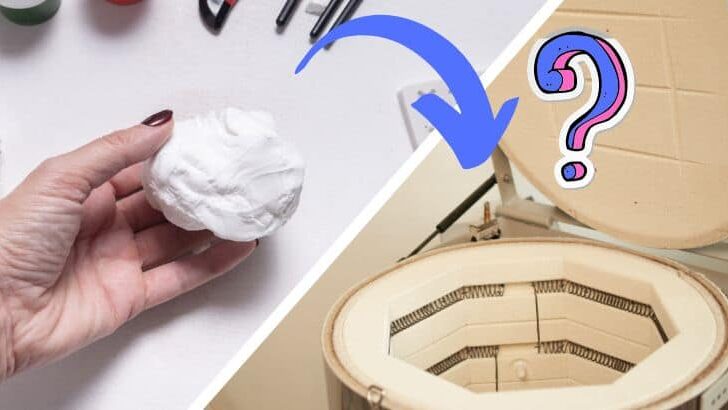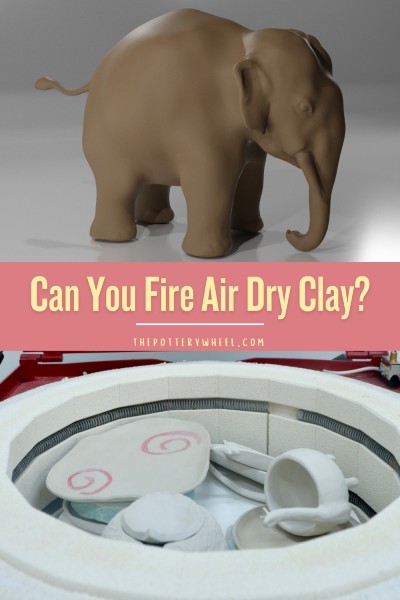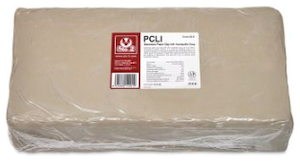Your cart is currently empty!
Can You Fire Air Dry Clay? – Do’s & Don’ts With Air Dry Clay
Published:
Last Updated:

Affiliate Disclaimer
As an affiliate, we may earn a commission from qualifying purchases. We get commissions for purchases made through links on this website from Amazon and other third parties.
Some air dry clay can look and feel a lot like regular pottery clay. But do they behave in the same way, and can you fire air-dry clay in a kiln?
No. Most air dry clay, like DAS modeling clay or Crayola Air Dry Clay, cannot go in the kiln. However, there are different types of air dry clay, and some brands are specially formulated so that they can be fired at lower temperatures. An example of this is Amaco Air Dry Clay.
But, if you can fire some air-dry clay and not others, how can you tell which clay is safe to go in the kiln? Let’s take a closer look at some of the differences and get a better idea of which air dry clay can be fired, and which can’t.

Different Types of Air Dry Clay
The term ‘Air Dry’ clay is an umbrella term. It is usually used to refer to a range of products that harden when they are exposed to air.
However, they are made of different ingredients, and this affects what you can and can’t do with them, including whether they can go in the kiln.
Air Dry Pottery Clay
Pottery clay is made of natural clay that has been processed to make it suitable for modeling and making pottery. The manufacturers will often add other ingredients to the clay to give it particular qualities such as plasticity or strength.
One way to give pottery clay extra strength is to blend fiber into the clay body. Some types of air dry clay harden when they dry in the air because they contain additional fiber. This fiber may be made from nylon or paper fibers.
As the clay dries, the fibers in the clay form something like a skeleton that binds the clay together and gives it strength.
Sometimes you can fire pottery clay that has been turned into an air dry clay in this way. A good example of air dry clay that you can fire is Amaco Air Dry Clay. This can be left to air dry, or it can be fired up to a temperature of 1940F (1060C).
The fibers in the clay burn out during the firing process, and the clay turns into ceramic ware.
The advantage of this is that your pottery or model will be stronger. Also, once it has been turned into ceramic material in the kiln, it won’t dissolve in water.
Air Dry Clay
Rather confusingly, there are other brands of clay called Air Dry Clay that you can’t fire! Here are some examples of those…
DAS Modeling Clay
DAS clay has been in circulation since 1963 and I have to confess it’s the first clay I ever touched when I was a kid. It’s made of ‘water, inorganic fillers, and vegetable binders’ (source).
Also, it contains paper fibers to give it strength and reduce the amount it shrinks when it dries (source).
But because the main ingredient is not natural pottery clay, it can’t go in a kiln. Pottery clay is made of clay particles that can withstand high temperatures. In fact, when it’s in the kiln, the clay particles bond together to form a strong ceramic network.
The materials out of which DAS clay can’t tolerate this heat. I’ve never tested this so, I’m not sure exactly what would happen if you fired DAS in a kiln. But it would either melt or burn. Either way, your pottery or model would not survive the heat of the kiln.
Having said that, I still have a soft spot for DAS and it’s a good place to start if you want to make models or hand-build with your clay.
Crayola Air Dry Clay
Crayola describes their Air Dry Clay as being made from ‘natural earth clay’ and says that it has a similar feel to porcelain. They don’t specify the other ingredients, but they do state that it should not be fired in a kiln or glazed with regular pottery glazes.
Typically, pottery kilns are fired at temperatures from 1832F (1000C) upwards, sometimes reaching 2372F (1300C). And unless the ingredients are formulated to withstand this heat, they will either melt or burn.
The fact that you can’t fire it suggests that this air dry clay contains fillers and binders that are not made of clay.
Paper Clay
Yet another kind of air-dry clay is paper clay. Again, rather confusingly there is more than one type of paper clay! However, there is a difference between ‘Paper Clay’ and ‘Paperclay’.
Natural Clay Paper Clay
Some paper clay is actually pottery clay that has been blended with paper fibers. The paper fibers make the clay stronger and reduce the chance that the pottery or model will crack when it dries.
As a result, paper clay is great for potters who want to hand-build large pieces of pottery, or for sculptors making larger clay models.
This kind of paper clay is not considered an air-dry clay. Although some air dry clay is strengthened with fibers, the idea behind paper clay is that you fire it in a kiln. During the firing process, the paper fibers burn out in the kiln and the ceramic piece is left behind.

Stoneware Paper Clay – View on Blick
Creative Paperclay
By contrast, there is another product called ‘paperclay’. A well-known brand of paperclay is Creative Paperclay, and this clay is designed to be air-dry clay.
Creative Paperclay is good because it can be used to model very fine details. In addition to this, it will stick to other materials like wood, metal, and canvas. As a result, it’s great for multi-media projects.
Also, unlike air dry clay, it is very lightweight, so it’s perfect for refined models and sculptures.
However, it would not survive in a kiln. Creative Paperclay is made from paper fibers, filler, glue, and other flammable ingredients. So, you can’t put Creative Paperclay in a kiln as it would be reduced to a pile of ash.
Nevertheless, once it has air-dried, it is quite hard and resilient. If you drop it, it’s unlikely to break.
In addition to that, you can carve it or sand it once it has been left to harden.
Polymer Clay
Strictly speaking polymer clay isn’t an air-dry clay because it needs to be baked in an oven to harden it. However, I thought it was worth a mention because it’s a popular alternative to pottery clay.
Polymer clay like Fimo or Sculpey does not contain any clay particles. Instead, it is made from PVC also known as Polyvinyl Chloride which has been blended with colorants, fillers, and plasticizers.
It must be baked in a domestic oven at around 230F/110C. If it is baked at higher temperatures there is a risk that the polymer clay will darken and become brittle. At kiln temperatures, polymer clay would likely become a charred lump on the kiln shelf.
Final Thoughts
Some clay is designed to be dual purpose, and it can be left to air dry or you can fire it in a kiln. These clays are mostly made from natural pottery clay some added fiber to give it strength.
However, other air dry clay has little or no natural clay content, and as a result, you cannot fire them.
Always read the manufacturer’s guidelines to establish what you can and can’t do with your air dry clay. If in doubt, reach out to the manufacturer’s customer services. In most instances, manufacturers are very happy to provide information to customers about their products.







